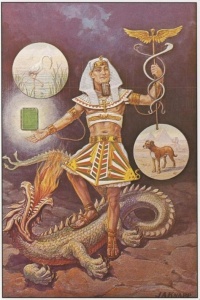Hermes Trismegistus
Hermes Trismegistus (Ancient Greek: Ἑρμῆς ὁ Τρισμέγιστος, "thrice-greatest Hermes") is the purported author of the Hermetic Corpus, a series of sacred texts that are the basis of Hermeticism. He is frequently seen as a combination of the Greek god Hermes and the Egyptian god Thoth. The texts attributed to him deal with magic, astrology, alchemy and philosophy. They are essentially religious neo-platonic texts dating no earlier than the second or third century CE.
In her Theosophical Glossary, Helena Petrovna Blavatsky described Hermes Trismegistus in this way:
Hermes Trismegistus (Gr.). The “ thrice great Hermes” , the Egyptian. The mythical personage after whom the Hermetic philosophy was named. In Egypt the God Thoth or Thot. A generic name of many ancient Greek writers on philosophy and Alchemy. Hermes Trismegistus is the name of Hermes or Thoth in his human aspect, as a god he is far more than this. As Hermes-Thoth-Aah, he is Thoth, the moon, i.e., his symbol is the bright side of the moon, supposed to contain the essence of creative Wisdom, “ the elixir of Hermes ” . As such he is associated with the Cynocephalus, the dog-headed monkey, for the same reason as was Anubis, one of the aspects of Thoth. (See “ Hermanubis” .) The same idea underlies the form of the Hindu God of Wisdom, the elephant-headed Ganesa, or Ganpat, the son of Parvati and Siva. (See “ Ganesa ” .) When he has the head of an ibis, he is the sacred scribe of the gods ; but even then he wears the crown atef and the lunar disk. He is the most mysterious of gods. As a serpent, Hermes Thoth is the divine creative Wisdom. The Church Fathers speak at length of Thoth-Hermes.[1]
Another Theosophist offers this information:
Thoth-Hermes was one of the King-Instructors, the "Sons of the Fire," who began in Lemuria in the Third Race to instruct infant humanity in the arts and sciences. The Egyptians always regarded Thoth-Hermes as a symbol of the Third Race. But in whichever of his characters Hermes appears, he is always credited as the first to teach the science of magic to the Egyptians.[2]
Online resources
Articles
- Hermes Trismegistus at Katinkahesselink.net.
- Hermes Trismegistus in Theosophy World.
Websites
- Resources on Hermes at Universal Theosophy
.
- ↑ Theosophical Glossary, page 140.
- ↑ Author Unknown, "Great Theosophists – Alchemy and the Alchemists" Theosophy 25 no. 11 (September, 1937), 490-496.
